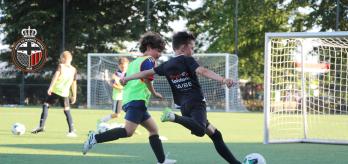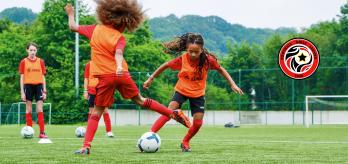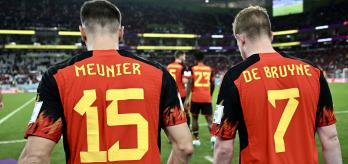As one of the region’s top non-professional clubs, KRC Gent offer a fully accredited youth academy that regularly produces talented players for Belgium’s elite centres. KRC Gent’s structured approach puts the focus on individual development. The club not only gives talented youngsters the opportunity to develop, but also acts as a springboard to elite Belgian football.
Youth in focus
Under Gert Desot, the head of the youth academy, the club has a clear strategy: the focus should always be on the development of players, rather than on short-term results. “We want creative players, players who take risks and learn from their mistakes,” stresses Desot. As such, all youth teams – from the U-6s to the U-21s – follow a monthly training plan based on a specific topic. While the training plan is implemented by the coaches, who are encouraged to put their own spin on the exercises, the underlying topic is always the same for all teams. The teams’ progress is assessed every two weeks to make sure that the players receive the best possible guidance.
Training based around smaller playing formats
The focus in this session is on the players’ positioning in relation to the ball, free play and communication on the pitch. As academy chief, Desot makes sure that all of his coaches encourage creativity and individual actions at all age levels. The club also sets great store on each child playing at least 75% of each match to ensure they gain as much experience as possible.
Coach Narcisse Moembo, who works with Gent's U-8s, always ensures that there is a balance between learning through free play and targeted training. At this level, the club's commitment to polishing diamonds is literally reflected on the tactics board, as it introduces the concept of a diamond as a starting formation in 5v5 games. Moembo is, however, also a great believer in coaches being able to add their own personal touch to training sessions and call upon their own experiences.
Building a future for talented youngsters
Between January and September 2024, no fewer than 21 players made the switch to elite clubs, proof positive of the club’s successful work at youth level. The objectives are clear: KRC Gent want to continue acting as a springboard and giving youngsters the chance to develop into top players. “Our job is to put the foundations in place so that each and every player can reach their full potential,” says Desot.
A talent development hotspot
The structured work of qualified coaches, even at U-8 level, shows that the club is on the right path towards further establishing itself as a vital part of the Belgian development pathway. At KRC Gent, it is not just about teaching children how to play football, but also about instilling a love of the game and the values of sport, and perhaps also polishing up the next diamond.
Part 1: Passing circuit
-
Split the players into 2 groups, each with a ball, 10m apart.
-
Place a cone in the middle as well as a player without a ball.
-
Place 1 cone on each side, 3m (diagonally) away from the middle cone.
-
A starts with the ball and passes to B in the middle.
-
A follows the pass and takes up a position alongside the middle cone.
-
B runs backwards towards the outside cone. Once there, B turns around and runs towards the other group.
-
A passes to B. B passes it back and runs to the outside cone.
-
A passes back to B, who from the outside cone dribbles towards the other group and passes to the next player.
Part 2: DUELS IN THE BOX
-
Mark out a 20m x 15m playing area with a 5m wide channel on either side.
-
Mark out a 10m x 6m area in the middle of the playing area.
-
Place 1 mini-goal at each end of the 2 wide channels (4 in total).
-
Split the players into 2 groups of 4 with 1 neutral player.
-
Place 2 players from each group plus the neutral player in the inner box, with 1v1 in the wide channels.
-
The coach starts the exercise by passing the ball to one of the players in the box.
-
The in-possession team’s objective in this 3v2 is to play the ball to a player in the wide channel and score.
-
If they do not manage to build an attack, the coach puts a second ball into play in the wide channel so that there is a scoring opportunity in every sequence.
Part 3: Dribbling circuit
-
Mark out a 5m x 5m area and place a white cone as shown in the graphic above.
-
Distribute the players as shown in the graphic above
-
Player A starts dribbling and performs a step-over at the height of the white cone.
-
Player A continues dribbling and then passes the ball to Player B, who moves up to the same side of the playing area
Part 4: FREE PLAY WITH AND AGAINST THE COACH
-
Mark a 35m x 20m playing area with a junior goal at either end of the playing area.
-
The players are split into 2 teams.
- 5v4
-
The coach is the goalkeeper for the team with the numerical disadvantage. The team with the numerical advantage plays without a goalkeeper.
-
The coach swaps with a team-mate to give them a go in goal and plays outfield in a “passive” role.
Context interview with Kris Van Der Haegen
How would you describe KRC Gent?
KRC Gent are one of the biggest and oldest amateur football clubs in Belgium. The club was professional at various points but now plays second fiddle to KAA Gent, the town’s professional club.
What is the relationship like between KRC Gent and KAA Gent?
The clubs work together closely and share training grounds. When a KAA Gent player isn’t up to par, they can move to KRC Gent, where they still play at a very high amateur level. The cooperation between the clubs means that every individual can develop and play at a level that is suitable for them.
Do youth players also move between the clubs?
In general, youth players stay at KRC Gent up until the age of 12 or 13, so that they can play in a familiar setting and with their friends. However, the coaches of both clubs do regularly exchange information to ensure that the youth players receive training that is best suited to their developmental stage.









